Evaluation of Multi-Crop Biofuel Pellet Properties and the Life Cycle Assessment
Abstract
1. Introduction
2. Materials and Methods
2.1. Design of the Research
2.2. Production of Biomass Pellets
2.3. Determination of the Main Characteristics of Biomass Pellets
2.3.1. Biometric Properties (Length, Diameter, Weight, Moisture, and Density)
2.3.2. Elemental Analysis
2.3.3. Calorific Value and Ash Content
2.3.4. Statistical Analysis
2.4. Life Cycle Assessment
2.4.1. Definition of the Aim and Scope
2.4.2. Functional Unit
2.4.3. System Boundary
2.4.4. Inventory Analysis
Biomass Production
Transportation
Pellet and Heat Production
- B is the amount of fuel burned, kg;
- Q is the amount of thermal energy produced, GJ;
- LCV is the lower calorific value of the fuel, MJ kg−1;
- ή—is the coefficient of efficiency of heat production in a boiler.
Ash Utilization
3. Results and Discussion
3.1. Biometric Properties of the Pellets
3.1.1. Length, Diameter, and Weight
3.1.2. Moisture Content and Density
3.2. Elemental Composition
3.3. Calorific Value and Ash Content
3.4. Life Cycle Assessment—Environmental Analysis of Pellet Production
4. Conclusions
Author Contributions
Funding
Institutional Review Board Statement
Data Availability Statement
Conflicts of Interest
References
- Kovacs, E.; Hoaghia, M.A.; Senila, L.; Scurtu, D.A.; Varaticeanu, C.; Roman, C.; Dumitras, D.E. Life Cycle Assessment of Biofuels Production Processes in Viticulture in the Context of Circular Economy. Agronomy 2022, 12, 1320. [Google Scholar] [CrossRef]
- Sarker, T.R.; Nanda, S.; Meda, V.; Dalai, A.K. Densification of Waste Biomass for Manufacturing Solid Biofuel Pellets: A Review. Environ. Chem. Lett. 2023, 21, 231–264. [Google Scholar] [CrossRef]
- Wang, J.; Fu, J.; Zhao, Z.; Bing, L.; Xi, F.; Wang, F.; Dong, J.; Wang, S.; Lin, G.; Yin, Y.; et al. Benefit Analysis of Multi-Approach Biomass Energy Utilization toward Carbon Neutrality. Innovation 2023, 4, 100423. [Google Scholar] [CrossRef] [PubMed]
- Choiński, B.; Szatyłowicz, E.; Zgłobicka, I.; Joka Ylidiz, M.A. Critical Investigation of Certificated Industrial Wood Pellet Combustion: Influence of Process Conditions on CO/CO2 Emission. Energies 2023, 16, 250. [Google Scholar] [CrossRef]
- Alazaiza, M.Y.D.; Ahmad, Z.; Albahnasawi, A.; Nassani, D.E.; Alenezi, R.A. Biomass Processing Technologies for Bioenergy Production: Factors for Future Global Market. Int. J. Environ. Sci. Technol. 2023, 21, 2307–2324. [Google Scholar] [CrossRef]
- Errera, M.R.; Dias, T.A.d.C.; Maya, D.M.Y.; Lora, E.E.S. Global bioenergy potentials projections for 2050. Biomass Bioenergy 2023, 170, 106721. [Google Scholar] [CrossRef]
- Cui, X.; Yang, J.; Wang, Z. A Multi-Parameter Optimization of the Bio-Pellet Manufacturing Process: Effect of Different Parameters and Different Feedstocks on Pellet Characteristics. Biomass Bioenergy 2021, 155, 106299. [Google Scholar] [CrossRef]
- Stachowicz, P.; Stolarski, M.J. Short Rotation Woody Crops and Forest Biomass Sawdust Mixture Pellet Quality. Ind. Crop. Prod. 2023, 197, 116604. [Google Scholar] [CrossRef]
- Tîtei, V.; Gadibadi, M.; Gutu, A.; Daraduda, N.; Mazare, V.; Armas, A.; Cerempei, V. Biomass quality of hemp, Cannabis sativa L., and prospects of its use for various energy purposes. Sci. Pap. Ser. A Agron. 2020, 63, 330–335. [Google Scholar]
- Okot, D.K.; Bilsborrow, P.E.; Phan, A.N. Briquetting characteristics of bean straw-maize cob blend. Biomass Bioenergy 2019, 126, 150–158. [Google Scholar] [CrossRef]
- Pradhan, P.; Mahajani, S.M.; Arora, A. Production and utilization of fuel pellets from biomass: A review. Fuel Process. Technol. 2018, 181, 215–232. [Google Scholar] [CrossRef]
- Wei, Z.; Cheng, Z.; Shen, Y. Recent development in production of pellet fuels from biomass and polyethylene (PE) wastes. Fuel 2024, 358 Pt A, 130222. [Google Scholar] [CrossRef]
- Pradhan, P.; Arora, A.; Mahajani, S.M. Factors Affecting the Quality of Fuel Pellets Produced from Waste Biomass. IOP Conf. Ser. Earth Environ. Sci. 2020, 463, 012013. [Google Scholar] [CrossRef]
- Endriss, F.; Kuptz, D.; Hartmann, H.; Brauer, S.; Kirchhof, R.; Kappler, A.; Thorwarth, H. Analytical Methods for the Rapid Determination of Solid Biofuel Quality. Chem. Ing. Tech. 2023, 95, 1503–1525. [Google Scholar] [CrossRef]
- Kafle, S.; Euh, S.H.; Cho, L.; Nam, Y.S.; Oh, K.C.; Choi, Y.S.; Oh, J.H.; Kim, D.H. Tar Fouling Reduction in Wood Pellet Boiler Using Additives and Study the Effects of Additives on the Characteristics of Pellets. Energy 2017, 129, 79–85. [Google Scholar] [CrossRef]
- Picchio, R.; Di Marzio, N.; Cozzolino, L.; Venanzi, R.; Stefanoni, W.; Bianchini, L.; Pari, L.; Latterini, F. Pellet production from pruning and alternative forest biomass: A review of the most recent research findings. Materials 2023, 16, 4689. [Google Scholar] [CrossRef] [PubMed]
- Zakir, I.; Wahab, A.A.; Abbas, T.; Haider, S.T.A.; Irum, S.; Sabir, S.; Hussain, S.; Ahmad, S. Cereal–vegetable intercropping: Hindrances and strategies to increase intercropping. Turk. J. Agric. For. 2023, 47, 1115–1129. [Google Scholar] [CrossRef]
- Campanhola, C.; Pandey, S. Chapter 26—Intercropping, Multicropping, and Rotations. In Sustainable Food and Agriculture; Campanhola, C., Pandey, S., Eds.; Elsevier: Cambridge, UK, 2019; pp. 243–248. [Google Scholar] [CrossRef]
- Li, C.; Stomph, T.J.; Makowski, D.; Li, H.; Zhang, C.; Zhang, F.; van der Werf, W. The Productive Performance of Intercropping. Proc. Natl. Acad. Sci. USA 2023, 120, e2201886120. [Google Scholar] [CrossRef] [PubMed]
- Nurgi, N.; Tana, T.; Dechassa, N.; Alemayehu, Y.; Tesso, B. Effects of Planting Density and Variety on Productivity of Maize-Faba Bean Intercropping System. Heliyon 2023, 9, e12967. [Google Scholar] [CrossRef]
- Visković, J.; Zheljazkov, V.D.; Sikora, V.; Noller, J.; Latković, D.; Ocamb, C.M.; Koren, A. Industrial Hemp (Cannabis sativa L.) Agronomy and Utilization: A Review. Agronomy 2023, 13, 931. [Google Scholar] [CrossRef]
- Wróbel, B.; Hryniewicz, M.; Kulkova, I.; Mazur, K.; Jakubowska, Z.; Borek, K.; Dobrzyński, J.; Konieczna, A.; Miecznikowski, A.; Piasecka-Jóźwiak, K.; et al. Fermentation Quality and Chemical Composition of Industrial Hemp (Cannabis sativa L.) Silage Inoculated with Bacterial Starter Cultures—A Pilot Study. Agronomy 2023, 13, 1371. [Google Scholar] [CrossRef]
- Osman, A.I.; Mehta, N.; Elgarahy, A.M.; Al-Hinai, A.; Al-Muhtaseb, A.H.; Rooney, D.W. Conversion of Biomass to Biofuels and Life Cycle Assessment: A Review. Environ. Chem. Lett. 2021, 19, 4075–4118. [Google Scholar] [CrossRef]
- Paolotti, L.; Martino, G.; Marchini, A.; Boggia, A. Economic and Environmental Assessment of Agro-Energy Wood Biomass Supply Chains. Biomass Bioenergy 2017, 97, 172–185. [Google Scholar] [CrossRef]
- Christoforou, E.; Fokaides, P.A. Environmental Assessment of Solid Biofuels. In Advances in Solid Biofuels. Green Energy and Technology; Springer: Cham, Switzerland, 2019; pp. 85–95. [Google Scholar] [CrossRef]
- Castro, J.S.; Ferreira, J.; Magalhães, I.B.; Jesus Junior, M.M.; Marangon, B.B.; Pereira, A.S.A.P.; Lorentz, J.F.; Gama, R.C.N.; Rodrigues, F.A.; Calijuri, M.L. Life Cycle Assessment and Techno-Economic Analysis for Biofuel and Biofertilizer Recovery as by-Products from Microalgae. Renew. Sustain. Energy Rev. 2023, 187, 113781. [Google Scholar] [CrossRef]
- Hamedani, S.R.; Colantoni, A.; Gallucci, F.; Salerno, M.; Silvestri, C.; Villarini, M. Comparative Energy and Environmental Analysis of Agro-Pellet Production from Orchard Woody Biomass. Biomass Bioenergy 2019, 129, 105334. [Google Scholar] [CrossRef]
- Wiloso, E.I.; Setiawan, A.A.R.; Prasetia, H.; Muryanto; Wiloso, A.R.; Subyakto; Sudiana, I.M.; Lestari, R.; Nugroho, S.; Hermawan, D.; et al. Production of Sorghum Pellets for Electricity Generation in Indonesia: A Life Cycle Assessment. Biofuel Res. J. 2020, 7, 1178–1194. [Google Scholar] [CrossRef]
- Kylili, A.; Christoforou, E.; Fokaides, P.A. Environmental evaluation of biomass pelleting using life cycle assessment. Biomass Bioenergy 2016, 84, 107–117. [Google Scholar] [CrossRef]
- Li, X.; Mupondwa, E.; Panigrahi, S.; Tabil, L.; Adapa, P. Life cycle assessment of densified wheat straw pellets in the Canadian Prairies. Int. J. Life Cycle Assess. 2012, 17, 420–431. [Google Scholar] [CrossRef]
- Prade, T.; Svensson, S.E.; Andersson, A.; Mattsson, J.E. Biomass and Energy Yield of Industrial Hemp Grown for Biogas and Solid Fuel. Biomass Bioenergy 2011, 35, 3040–3049. [Google Scholar] [CrossRef]
- Hu, J.; Lei, T.; Wang, Z.; Yan, X.; Shi, X.; Li, Z.; He, X.; Zhang, Q. Economic, Environmental and Social Assessment of Briquette Fuel from Agricultural Residues in China—A Study on Flat Die Briquetting Using Corn Stalk. Energy 2014, 64, 557–566. [Google Scholar] [CrossRef]
- Nilsson, D.; Bernesson, S.; Hansson, P.A. Pellet Production from Agricultural Raw Materials—A Systems Study. Biomass Bioenergy 2011, 35, 679–689. [Google Scholar] [CrossRef]
- Martín-Gamboa, M.; Marques, P.; Freire, F.; Arroja, L.; Dias, A.C. Life Cycle Assessment of Biomass Pellets: A Review of Methodological Choices and Results. Renew. Sustain. Energy Rev. 2020, 33, 110278. [Google Scholar] [CrossRef]
- Miedaner, T.; Juroszek, P. Global warming and increasing maize cultivation demand comprehensive efforts in disease and insect resistance breeding in north-western Europe. Plant Pathol. 2020, 70, 1032–1046. [Google Scholar] [CrossRef]
- Grippi, D.; Clemente, R.; Bernal, M.P. Chemical and bioenergetic characterization of biofuels from plant biomass: Perspectives for Southern Europe. Appl. Sci. 2020, 10, 3571. [Google Scholar] [CrossRef]
- Šarauskis, E.; Romaneckas, K.; Jasinskas, A.; Kimbirauskienė, R.; Naujokienė, V. Improving energy efficiency and environmental mitigation through tillage management in faba bean production. Energy 2020, 209, 118453. [Google Scholar] [CrossRef]
- Kraszkiewicz, A.; Kachel, M.; Parafiniuk, S.; Zając, G.; Niedziółka, I.; Sprawka, M. Assessment of the Possibility of Using Hemp Biomass (Cannabis sativa L.) for Energy Purposes: A Case Study. Appl. Sci. 2019, 9, 4437. [Google Scholar] [CrossRef]
- Romaneckas, K.; Švereikaitė, A.; Kimbirauskienė, R.; Sinkevičienė, A.; Balandaitė, J. The Energy and Environmental Evaluation of Maize, Hemp and Faba Bean Multi-Crops. Agronomy 2023, 13, 2316. [Google Scholar] [CrossRef]
- LST EN ISO 17225-6:2021; Solid Biofuels—Fuel Specifications and Classes—Part 6: Graded Non-Woody Pellets. Lithuanian Standards Board: Vilnius, Lithuania, 2021.
- LST EN ISO 18134-1:2016; Determination of Moisture Content—Oven Dry Method—Part 1: Total Moisture-Reference Method. Lithuanian Standards Board: Vilnius, Lithuania, 2016.
- LST EN ISO 16948:2015; Solid Biofuels—Determination of Total Content of Carbon, Hydrogen and Nitrogen. Lithuanian Standards Board: Vilnius, Lithuania, 2015.
- LST EN ISO 16994:2016; Solid Biofuels—Determination of Total Content of Sulfur and Chlorine. Lithuanian Standards Board: Vilnius, Lithuania, 2016.
- LST EN ISO 18125:2017; Solid Biofuels—Determination of Calorific Value. Lithuanian Standards Board: Vilnius, Lithuania, 2017.
- LST EN ISO 18122:2016; Solid Biofuels—Determination of Ash Content. Lithuanian Standards Board: Vilnius, Lithuania, 2016.
- EN ISO 14040:2006; Environmental Management—Life Cycle Assessment—Principles and Framework. International Organization for Standardization: Geneva, Switzerland, 2006.
- Guinée, J.B.; Heijungs, R.; Huppes, G.; Kleijn, R.; de Koning, A.; van Oers, L.; Wegener Sleeswijk, A.; Suh, S.; Udo de Haes, H.A.; de Bruijn, H.; et al. Life Cycle Assessment. Operational Guide to the ISO Standards. I: LCA in Perspective. IIa: Guide. IIb: OperatiCastellonal Annex. III: Scientific Background; Ministries of the Netherlands: Dordrecht, The Netherlands, 2002; p. 692.
- Wernet, G.; Bauer, C.; Steubing, B.; Reinhard, J.; Moreno-Ruiz, E.; Weidema, B. The ecoinvent database version 3 (part I): Overview and methodology. Int. J. Life Cycle Assess. 2016, 21, 1218–1230. [Google Scholar] [CrossRef]
- Sadaghiani, S.; Mafakheri, F.; Chen, Z. Life Cycle Assessment of Bioenergy Production Using Wood Pellets: A Case Study of Remote Communities in Canada. Energies 2023, 16, 5697. [Google Scholar] [CrossRef]
- Demarco, M.; Fortier, M.P. Functional unit choice in space conditioning life cycle assessment: Review and recommendations. Energy Build. 2022, 255, 111626. [Google Scholar] [CrossRef]
- Dzikuć, M.; Piwowar, A. Life Cycle Assessment as an Eco-Management Tool within the Power Industry. Pol. J. Environ. Stud. 2015, 24, 2381–2385. [Google Scholar] [CrossRef] [PubMed]
- Mannheim, V.; Nehéz, K.; Brbhan, S.; Bencs, P. Primary Energy Resources and Environmental Impacts of Various Heating Systems Based on Life Cycle Assessment. Energies 2023, 16, 6995. [Google Scholar] [CrossRef]
- Ruiz, D.; Miguel, G.S.; Corona, B.; López, F.R. LCA of a multifunctional bioenergy chain based on pellet production. Fuel 2018, 215, 601–611. [Google Scholar] [CrossRef]
- Carlon, E.; Schwarz, M.; Golicza, L.; Verma, V.K.; Prada, A.; Baratieri, M.; Haslinger, W.; Schmidl, C. Efficiency and operational behaviour of small-scale pellet boilers installed in residential buildings. Appl. Energy 2015, 155, 854–865. [Google Scholar] [CrossRef]
- Wang, Y.; Wang, J.; Zhang, X.; Grushecky, S. Environmental and economic assessments and uncertainties of multiple lignocellulosic biomass utilization for bioenergy products: Case studies. Energies 2020, 13, 6277. [Google Scholar] [CrossRef]
- Muazu, R.I.; Borrion, A.L.; Stegemann, J.A. Life cycle assessment of biomass densification systems. Biomass Bioenergy 2017, 107, 384–397. [Google Scholar] [CrossRef]
- Adams, P.W.R.; Shirley, J.E.J.; Mcmanus, M.C. Comparative cradle-to-gate life cycle assessment of wood pellet production with torrefaction. Appl. Energy 2015, 138, 367–380. [Google Scholar] [CrossRef]
- Manandhar, A.; Shah, A. Life cycle assessment of feedstock supply systems for cellulosic biorefineries using corn stover transported in conventional bale and densified pellet formats. J. Clean. Prod. 2017, 166, 601–614. [Google Scholar] [CrossRef]
- Jasinskas, A.; Streikus, D.; Vonžodas, T. Fibrous hemp (Felina 32, USO 31, Finola) and fibrous nettle processing and usage of pressed biofuel for energy purposes. Renew. Energy 2020, 149, 11–21. [Google Scholar] [CrossRef]
- Minajeva, A. The Investigation of the Technological Process of Faba Bean and Potato Waste Treatment and Usage for Energy Conversion and the Environmental Impact Assessment. Doctoral Dissertation, Vytautas Magnus University, Kaunas, Lithuania, 2022. [Google Scholar]
- Adapa, P.; Tabil, L.; Schoenau, G. Pelleting characteristics of selected biomass with and without steam explosion pretreatment. Int. J. Agric. Biol. Eng. 2010, 3, 62–79. [Google Scholar] [CrossRef]
- Azócar, L.; Hermosilla, N.; Gay, A.; Rocha, S.; Díaz, J.; Jara, P. Brown pellet production using wheat straw from southern cities in Chile. Fuel 2019, 237, 823–832. [Google Scholar] [CrossRef]
- Niedziółka, I.; Szpryngiel, M.; Kachel-Jakubowska, M.; Kraszkiewicz, A.; Zawiślak, K.; Sobczak, P.; Nadulski, R. Assessment of the Energetic and Mechanical Properties of Pellets Produced from Agricultural Biomass. Renew. Energy 2015, 76, 312–317. [Google Scholar] [CrossRef]
- Rabbat, C.; Villot, A.; Awad, S.; Andrès, Y. Gaseous and particulate matter emissions from the combustion of biomass-based insulation materials at end-of-life in a small-scale biomass heating boiler. Fuel 2023, 338, 127182. [Google Scholar] [CrossRef]
- Theerarattananoon, K.; Xu, F.; Wilson, J.; Staggenborg, S.; Mckinney, L.; Vadlani, P.; Pei, Z.; Wang, D. Effects of the Pelleting Conditions on Chemical Composition and Sugar Yield of Corn Stover, Big Bluestem, Wheat Straw, and Sorghum Stalk Pellets. Bioprocess Biosyst. Eng. 2012, 35, 615–623. [Google Scholar] [CrossRef] [PubMed]
- Harun, N.Y.; Afzal, M.T. Effect of Particle Size on Mechanical Properties of Pellets Made from Biomass Blends. Procedia Eng. 2016, 148, 93–99. [Google Scholar] [CrossRef]
- Bilandzija, N.; Voca, N.; Jelcic, B.; Jurisic, V.; Matin, A.; Grubor, M.; Kricka, T. Evaluation of Croatian Agricultural Solid Biomass Energy Potential. Renew. Sustain. Energy Rev. 2018, 93, 225–230. [Google Scholar] [CrossRef]
- Podleśna, A. Effect of fertilization on content and uptake of chlorine by oilseed rape under pot experiment conditions. J. Elem. 2009, 14, 773–778. [Google Scholar] [CrossRef]
- Zapata, S.; Canalís, P.; Royo, J.; Gómez, M.; Bartolomé, C. Combustion Performance of Agropellets in an Experimental Fixed Bed Reactor versus a Commercial Grate Boiler. Validation of Ash Behavior. ACS Omega 2023, 8, 29485–29499. [Google Scholar] [CrossRef] [PubMed]
- Canabal, A.I.; Castiñeiras, J.P.; Añón, J.A.R.; Fraga, C.E.; Soalleiro, R.R. Elemental Composition of Raw and Torrefied Pellets Made from Pine and Pine-Eucalyptus Blends. Biomass Bioenergy 2023, 177, 106951. [Google Scholar] [CrossRef]
- Vasileiadou, A.; Papadopoulou, L.; Zoras, S.; Iordanidis, A. Development of a Total Ash Quality Index and an Ash Quality Label: Comparative Analysis of Slagging/Fouling Potential of Solid Biofuels. Environ. Sci. Pollut. Res. 2022, 29, 42647–42663. [Google Scholar] [CrossRef]
- Zardzewiały, M.; Bajcar, M.; Puchalski, C.; Gorzelany, J. The Possibility of Using Waste Biomass from Selected Plants Cultivated for Industrial Purposes to Produce a Renewable and Sustainable Source of Energy. Appl. Sci. 2023, 13, 3195. [Google Scholar] [CrossRef]
- Toscano, G.; De Francesco, C.; Gasperini, T.; Fabrizi, S.; Duca, D.; Ilari, A. Quality Assessment and Classification of Feedstock for Bioenergy Applications Considering ISO 17225 Standard on Solid Biofuels. Resources 2023, 12, 69. [Google Scholar] [CrossRef]
- Mack, R.; Schön, C.; Kuptz, D.; Hartmann, H.; Brunner, T.; Obernberger, I.; Behr, H.M. Influence of Wood Species and Additives on Emission Behavior of Wood Pellets in a Residential Pellet Stove and a Boiler. Biomass Convers. Biorefin. 2023, 1–20. [Google Scholar] [CrossRef]
- Quinteiro, P.; Tarelho, L.; Marques, P.; Martín-Gamboa, M.; Freire, F.; Arroja, L.; Cláudia, A. Life Cycle Assessment of Wood Pellets and Wood Split Logs for Residential Heating. Sci. Total Environ. 2019, 689, 580–589. [Google Scholar] [CrossRef]
- Esquiaqui, L.; de Oliveira Miranda Santos, S.D.F.; Ugaya, C.M.L. A Systematic Review of Densified Biomass Products Life Cycle Assessments. Int. J. Environ. Sci. Technol. 2023, 20, 9311–9334. [Google Scholar] [CrossRef]


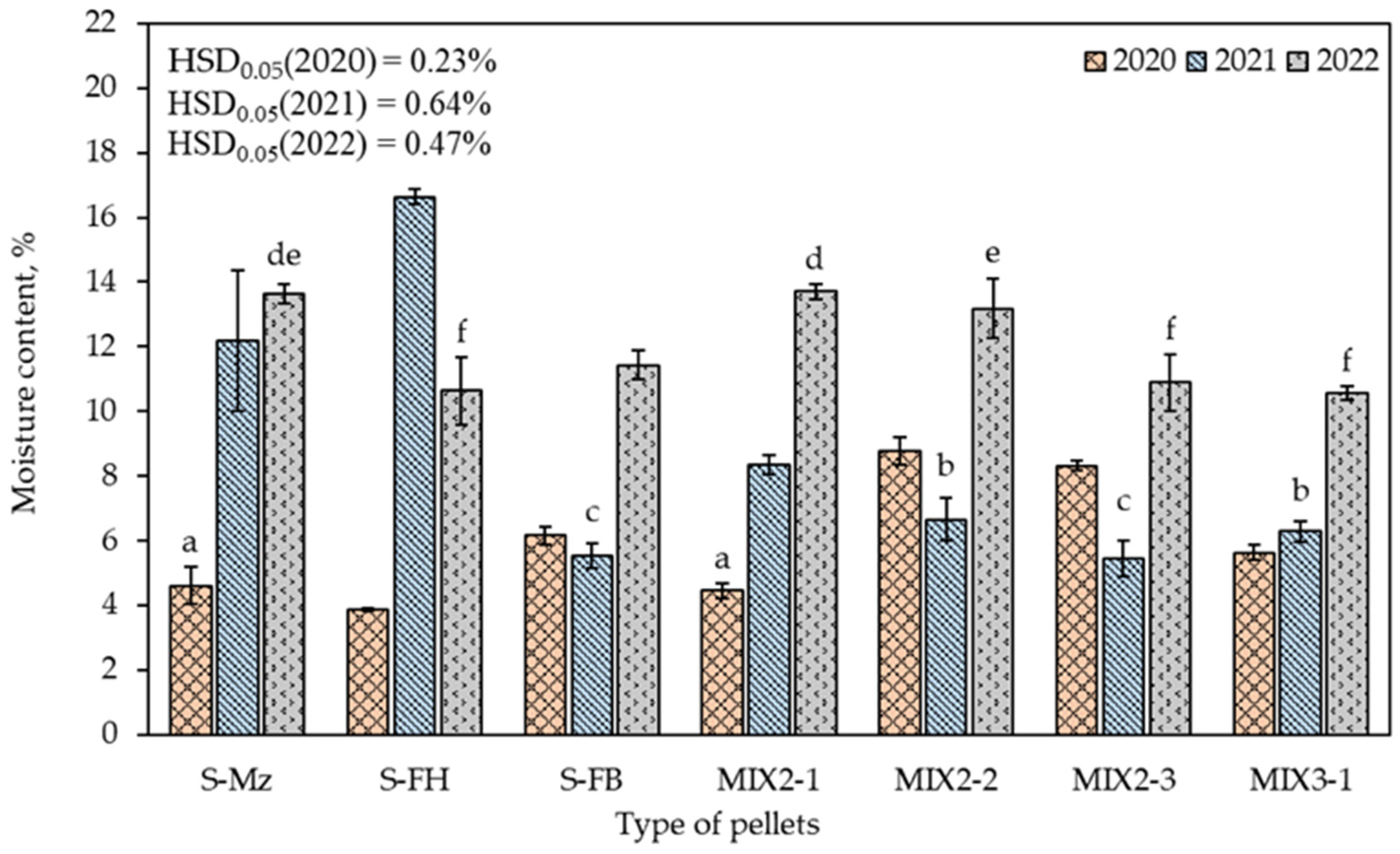
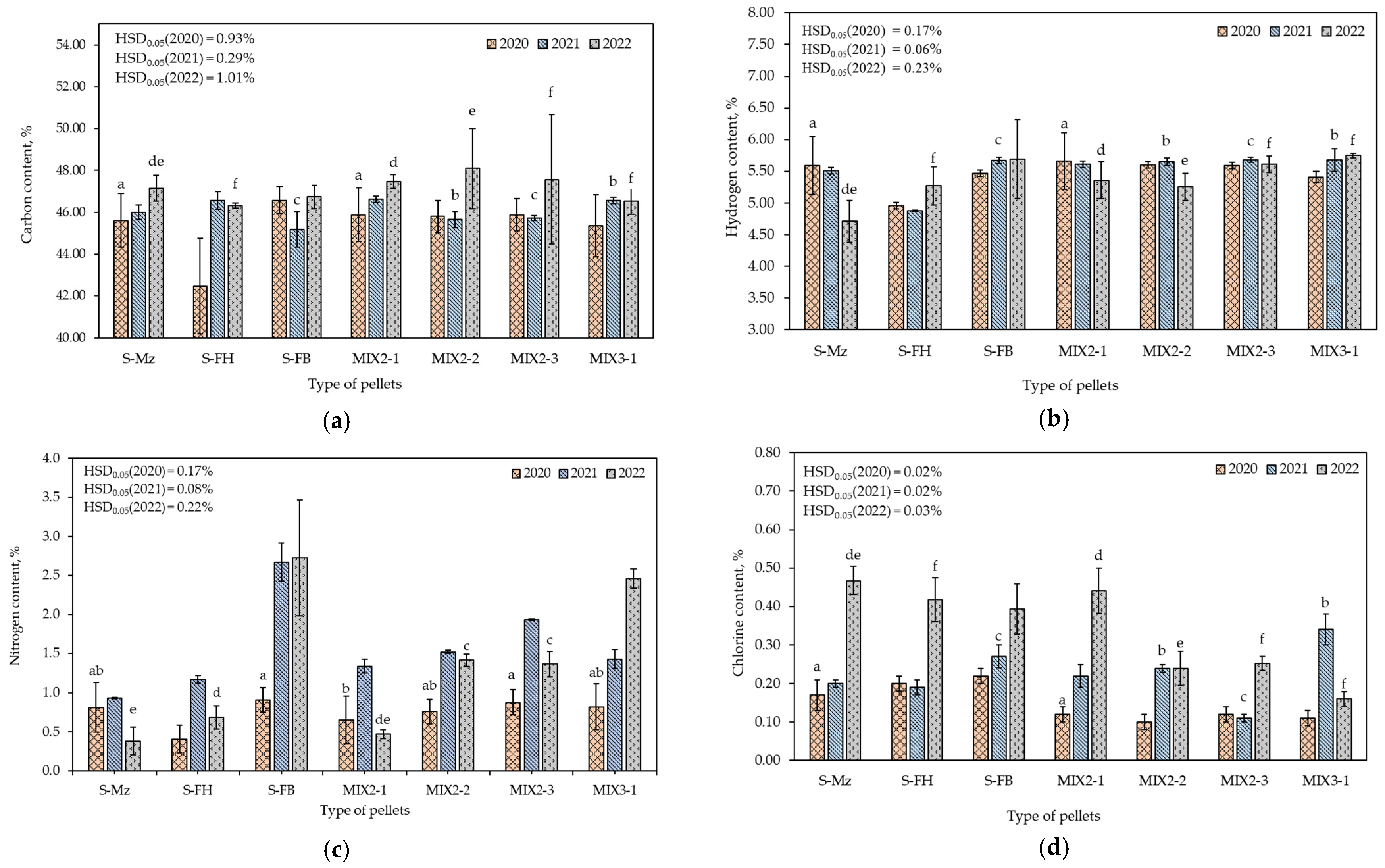
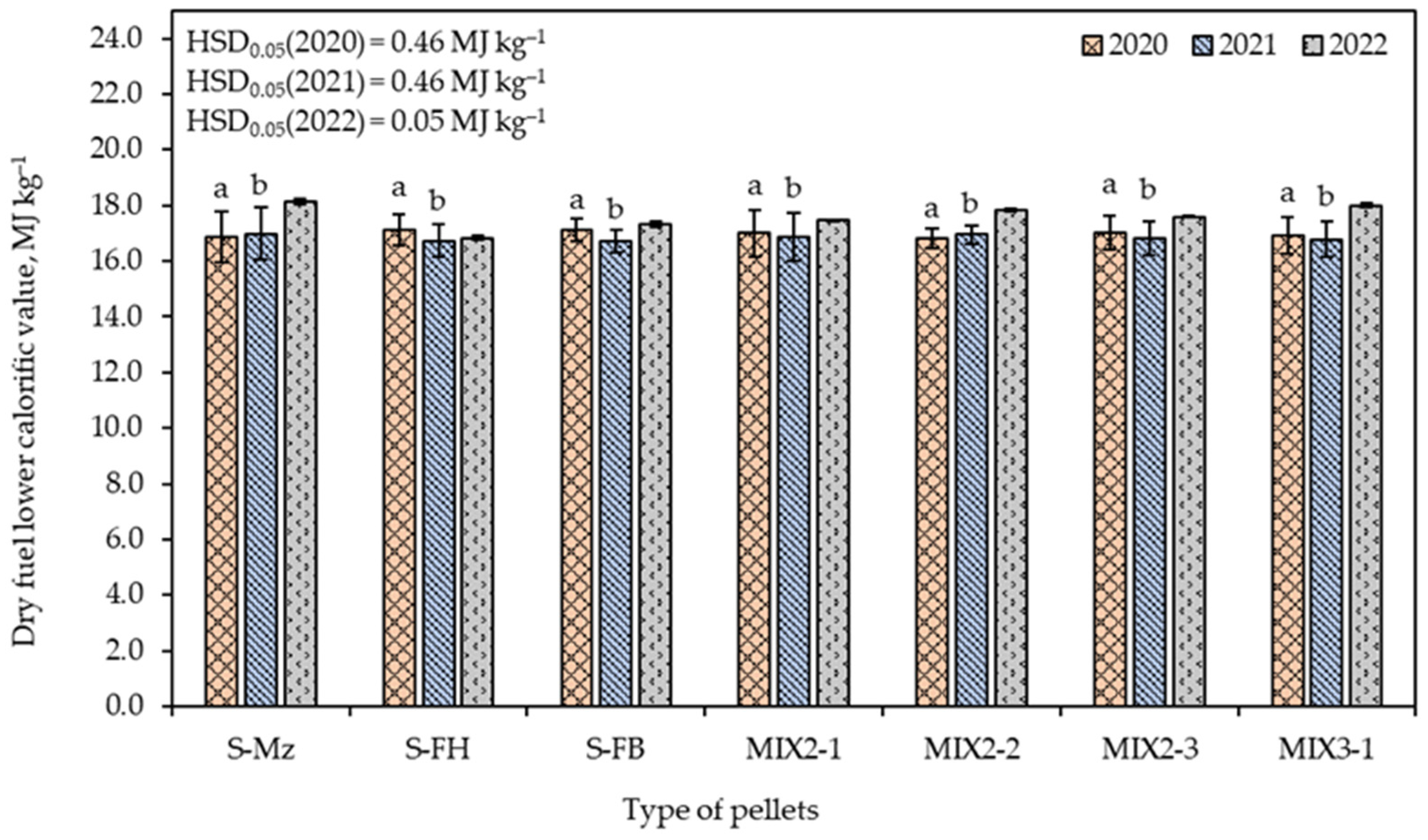


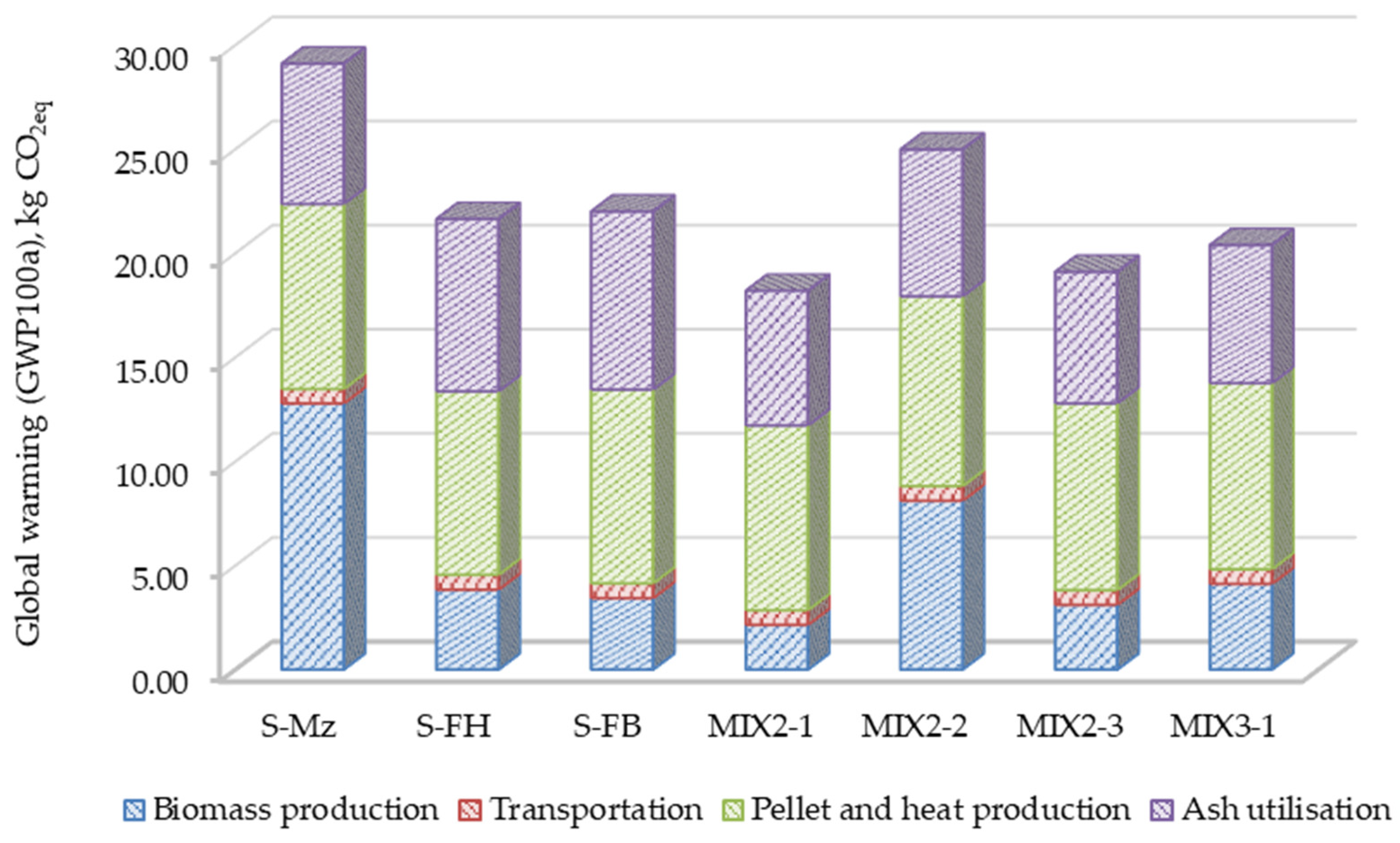

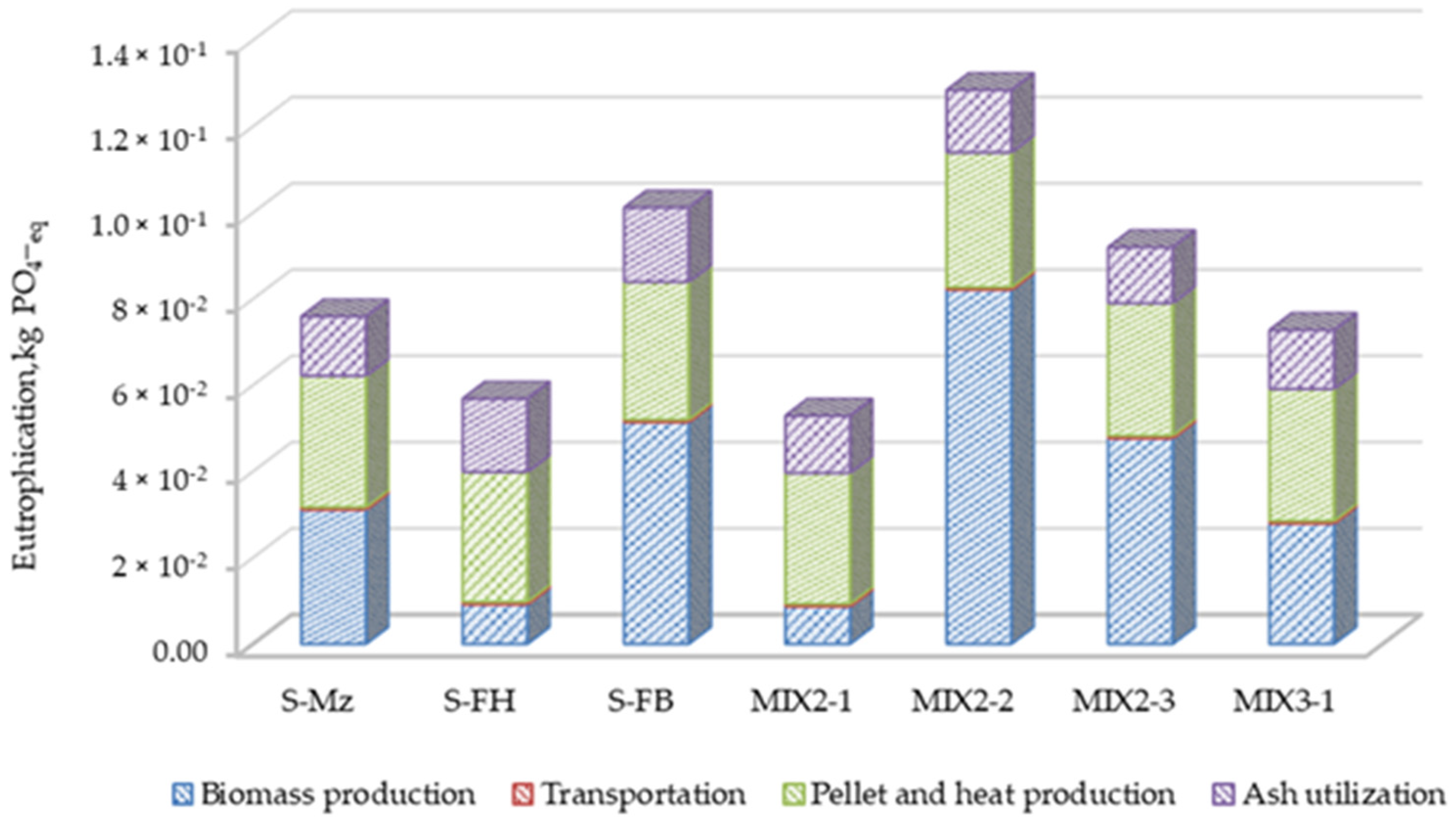
| Item | Unit | S-Mz | S-FH | S-FB | MIX2-1 | MIX2-2 | MIX2-3 | MIX3-1 |
|---|---|---|---|---|---|---|---|---|
| Content of K in ash | g kg−1 | 183.01 | 156.14 | 229.16 | 206.94 | 171.42 | 245.13 | 222.03 |
| kg FU−1 | 0.70 | 0.76 | 0.95 | 0.79 | 0.71 | 0.91 | 0.88 | |
| Content of P in ash | g kg−1 | 21.35 | 29.38 | 40.64 | 33.89 | 45.54 | 42.98 | 39.72 |
| kg FU−1 | 0.08 | 0.14 | 0.17 | 0.13 | 0.19 | 0.16 | 0.16 |
| Item | Scenarios | Data Source | ||||||
|---|---|---|---|---|---|---|---|---|
| S-Mz | S-FH | S-FB | MIX2-1 | MIX2-2 | MIX2-3 | MIX3-1 | ||
| A. Input | ||||||||
| Fertilizer: | ||||||||
| N, kg | 0.64 | 0.32 | 0.30 | 0.24 | 0.37 | 0.26 | 0.13 | [39] 1 |
| P, kg | 0.64 | 0.32 | 0.30 | 0.24 | 0.37 | 0.26 | 0.13 | |
| K, kg | 0.64 | 0.32 | 0.30 | 0.24 | 0.37 | 0.26 | 0.13 | |
| Maize seeds, kg | 0.90 | 0.36 | 0.74 | 0.10 | [39] 2 | |||
| Hemp seeds, kg | 0.16 | 0.08 | 0.12 | 0.04 | ||||
| Faba bean seeds, kg | 2.38 | 3.27 | 2.16 | 1.04 | ||||
| Biomass (dry basis), kg | 63.41 | 65.04 | 64.45 | 64.24 | 63.92 | 64.12 | 63.75 | [39] 3 |
| Maize biomass (dry basis), kg | 63.41 | 12.50 | 28.89 | 3.78 | ||||
| Hemp biomass (dry basis), kg | 65.04 | 51.74 | 50.89 | 20.13 | ||||
| Faba bean biomass (dry basis), kg | 64.45 | 35.03 | 13.23 | 39.85 | ||||
| Electricity for biomass granulation, kWh | 5.07 | 4.34 | 5.73 | 4.71 | 5.40 | 4.99 | 5.01 | [58,59,60] 4 |
| Electricity for ash-based fertilizers, kWh | 1.92 | 2.44 | 2.07 | 1.91 | 2.06 | 1.86 | 1.98 | [30,61] 4 |
| Cattle manure for ash granulation, kg 5 | 15.37 | 19.50 | 16.58 | 15.26 | 16.50 | 14.87 | 15.81 | - |
| B. Output | ||||||||
| Biomass pellets (dry basis), kg | 63.41 | 65.04 | 64.45 | 64.24 | 63.92 | 64.12 | 63.75 | Data source—our study |
| Ash, kg | 3.84 | 4.88 | 4.15 | 3.82 | 4.12 | 3.72 | 3.95 | |
| Ash fertilizer mixture, kg | 19.22 | 24.38 | 20.73 | 19.08 | 20.62 | 18.58 | 19.76 | |
| Impact Category | Unit | S-Mz | S-FH | S-FB | MIX2-1 | MIX2-2 | MIX2-3 | MIX3-1 |
|---|---|---|---|---|---|---|---|---|
| AD | kg Sbeq | 1.7 × 10−3 | 1.7 × 10−3 | 1.6 × 10−3 | 1.5 × 10−3 | 1.6 × 10−3 | 1.5 × 10−3 | 1.6 × 10−3 |
| ADF | MJ | 321.21 | 215.69 | 216.49 | 177.85 | 250.03 | 184.11 | 204.06 |
| GWP | kg CO2eq | 29.11 | 21.64 | 22.01 | 18.20 | 24.99 | 19.11 | 20.39 |
| ODP | kg CFC-11eq | 3.5 × 10−6 | 2.8 × 10−6 | 2.8 × 10−6 | 2.2 × 10−6 | 3.0 × 10−6 | 2.3 × 10−6 | 2.5 × 10−6 |
| HT | kg 1,4-DBeq | 82.19 | 80.62 | 76.85 | 73.71 | 78.55 | 73.26 | 74.88 |
| FWAE | kg 1,4-DBeq | 53.24 | 51.30 | 49.25 | 47.12 | 50.67 | 46.68 | 47.96 |
| MAE | kg 1,4-DBeq | 76,829.67 | 73,636.66 | 70,789.12 | 67,309.71 | 72,847.00 | 66,833.65 | 68,748.25 |
| TE | kg 1,4-DBeq | 1.1 × 10−1 | 9.4 × 10−2 | 8.7 × 10−2 | 8.4 × 10−2 | 9.4 × 10−2 | 8.2 × 10−2 | 8.8 × 10−2 |
| PO | kg C2H4eq | 1.1 × 10−2 | 1.0 × 10−2 | 9.8 × 10−3 | 8.7 × 10−3 | 1.0 × 10−2 | 8.7 × 10−3 | 8.9 × 10−3 |
| AP | kg SO2eq | 1.6 × 10−1 | 1.2 × 10−1 | 1.3 × 10−1 | 1.0 × 10−1 | 1.5 × 10−1 | 1.1 × 10−1 | 1.1 × 10−1 |
| EP | kg PO4—eq | 7.6 × 10−2 | 5.7 × 10−2 | 1.0 × 10−1 | 5.3 × 10−2 | 1.3 × 10−1 | 9.2 × 10−2 | 7.3 × 10−2 |
Disclaimer/Publisher’s Note: The statements, opinions and data contained in all publications are solely those of the individual author(s) and contributor(s) and not of MDPI and/or the editor(s). MDPI and/or the editor(s) disclaim responsibility for any injury to people or property resulting from any ideas, methods, instructions or products referred to in the content. |
© 2024 by the authors. Licensee MDPI, Basel, Switzerland. This article is an open access article distributed under the terms and conditions of the Creative Commons Attribution (CC BY) license (https://creativecommons.org/licenses/by/4.0/).
Share and Cite
Petlickaitė, R.; Jasinskas, A.; Venslauskas, K.; Navickas, K.; Praspaliauskas, M.; Lemanas, E. Evaluation of Multi-Crop Biofuel Pellet Properties and the Life Cycle Assessment. Agriculture 2024, 14, 1162. https://doi.org/10.3390/agriculture14071162
Petlickaitė R, Jasinskas A, Venslauskas K, Navickas K, Praspaliauskas M, Lemanas E. Evaluation of Multi-Crop Biofuel Pellet Properties and the Life Cycle Assessment. Agriculture. 2024; 14(7):1162. https://doi.org/10.3390/agriculture14071162
Chicago/Turabian StylePetlickaitė, Rita, Algirdas Jasinskas, Kęstutis Venslauskas, Kęstutis Navickas, Marius Praspaliauskas, and Egidijus Lemanas. 2024. "Evaluation of Multi-Crop Biofuel Pellet Properties and the Life Cycle Assessment" Agriculture 14, no. 7: 1162. https://doi.org/10.3390/agriculture14071162
APA StylePetlickaitė, R., Jasinskas, A., Venslauskas, K., Navickas, K., Praspaliauskas, M., & Lemanas, E. (2024). Evaluation of Multi-Crop Biofuel Pellet Properties and the Life Cycle Assessment. Agriculture, 14(7), 1162. https://doi.org/10.3390/agriculture14071162







